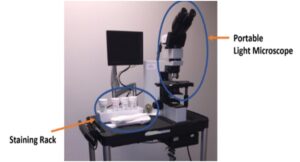
RAPID ONSITE EVALUATION (R.O.S.E.)
Q. WHAT IS R. O. S. E.?
A. R.O.S.E stands for Rapid OnSite Evaluation
With R.O.S.E., the pathologist can immediately evaluate fine needle aspirations or even fine needle biopsies of a patient’s sample by doing cytologic preparations of these samples (literally smearing the cells on a slide!). Results are obtained within a few minutes. A decision can be then made by the clinical team on the next steps of intervention based on the results obtained.
Q.What Equipment is required for a R.O.S.E?
A. All we need is a countertop and an electrical outlet. The example shows a portable light microscope (sometimes connected to a screen for telecytopathology) and a staining rack with both slides and our Diff quick (Romanowsky) stains for rapid staining of your samples.

Q. WHERE CAN A R.O.S.E. BE PERFORMED?
A. R.O.S.E. can be performed during fine needle sampling of any lesion in the operating theatre, the endoscopy suite, the doctor’s office or in the interventional radiology suite.
After we receive the needle, we place a drop of the sample on the slide and smear it. After it air dries we then stain using minimal material, this is a manual process that takes at most 2 minutes.The pathologist will then read the sample after mounting and coverslipping.

Q. BENEFITS OF R.O.S.E.?
A. A R.O.S.E. procedure can save you both time and money due to the literal and figurative costs of repeat samples.
We can then triage the specimen based on the pathologist’s call.If inadequate, additional samples can be taken, if lymphoma we can place in saline or RPMI for flow cytometry, if malignant we can place most of the specimen for cellblock preparation for immunohistochemistry and, if needed, we can give you a preliminary diagnosis so that you can get a head start on next steps for patient treatment.
Q. When can a R.O.S.E. be done?
A. R.O.S.E. has been performed for evaluation of transbronchial and percutaneous FNA lung samples, thyroid and pancreas lesions and lymph nodes (sentinel, suspicious and for staging) in both the adult and paediatric populations.
When R.O.S.E. is used fewer passes for EBUS (Endoscopic ultrasound) FNA of endobronchial samples are required and it decreases the need for repeat FNAs of pancreatic samples.

